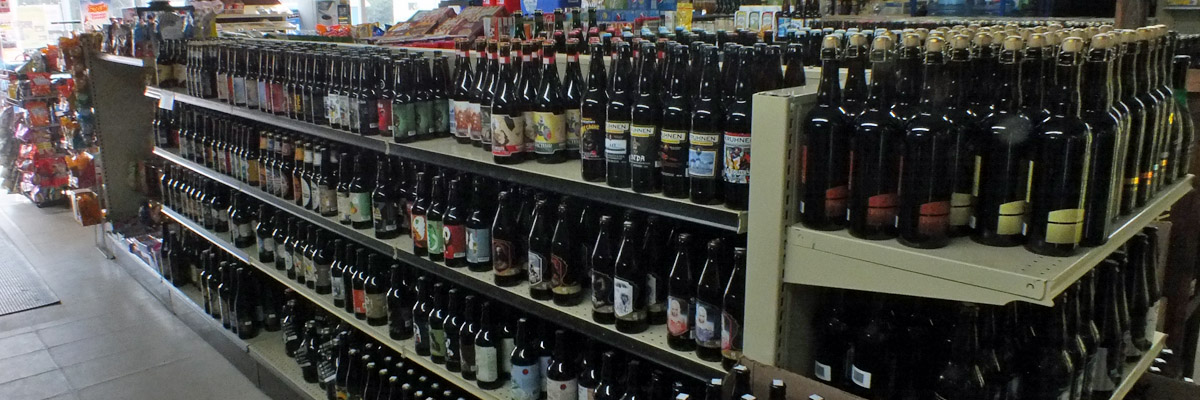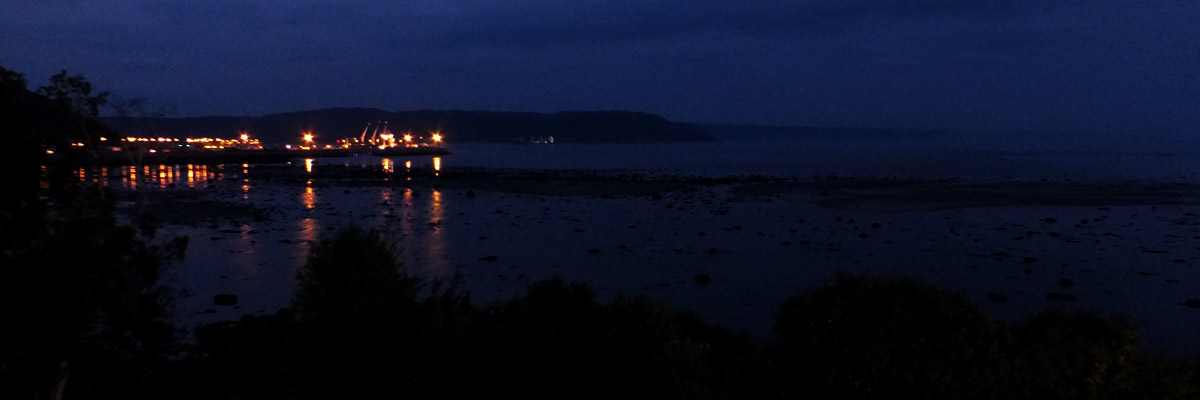
from Saguenay to Øresund


30 August 2015
The North Atlantic Arc Home
| August | September | October |
| S | M | T | W | T | F | S |
| 18 | 19 | 20 | 21 | 22 | ||
| 23 | 24 | 25 | 26 | 27 | 28 | 29 |
| 30 | 31 | 1 | 2 | 3 | 4 | 5 |
| 3 | ||||||
| 4 | 5 | 6 | 7 | 8 | 9 | 10 |
| 11 | 12 | 13 | 14 | 15 | 16 | 17 |
| 18 | 19 | 20 | 21 |
 |
|
Sunday 30 August 2015--Away down the north shore of the St Lawrence
we go. Near Les Escoumins, a half hour along, Marc suggests we stop at a
Petro-Canada, just another ordinary roadside gas station and convenience
store...except Marc already knows what we will find inside: row after row of
Québecois beer. Holy moley. I grab a few more bottles for the cooler.
Obviously, Marc has been here before; we are, in fact, not far from the turnoff
for a fishing camp in which Marc's brother owns a share. Once you hit the
turnoff, he tells me, there is a very long and bumpy ride on unpaved road,
followed by a trip across the lake in the caretaker's boat. The annual fishing trip
is a family affair, with Marc, his brother, their daughters, husbands and
boyfriends, grandkids, and sometimes Marc's cousins from Texas. (Marc's
uncle was sent to open a paper mill in the Lone Star state in the '50s.) I have
more than once heard the story about them all rising on an early June morning to
find themselves in the middle of a late-season snow squall. Marc and his brother
quite sensibly thought they'd wait it out before going out to fish, but the
Texans, pulling on their cold-weather gear, were ready to go. No doubt they
were pleased to be able to add to their store of Texan tall tales, with a story of
Canadian wilderness adventure that their friends at home could not match.
"Les Escoumins" is the French name for a village the local Innu call Essipit. It's a small place, population less than 300, but it benefits from being the northern terminal for a ferry that lands at Trois-Pistoles on the south shore. Unfortunately, we do not think to leave the main road for a look around*. We do stop at Forestville, however, another 45 minutes or so up the road. Here we see the remains of a flume, several kilometers in length, a leftover artifact of the logging era. Forestville is also a ferry terminal, with service to Rimouski. Another thirty miles along, we make a short diversion to see the Innu village of Pessamit. This occupies a site used by the Innu for thousands of years, at the mouth of the Betsiamites River. I'm not sure what to make of it, on a quick drive- through. The houses look reasonably well maintained, but no one seems to bother with landscaping of any kind, which lends the place an air of poverty. That's perhaps an unfair judgment of a population that was basically nomadic just a hundred years or so ago. Late-model SUVs in many of the driveways are an indication of a degree of prosperity, at least. But I've learned that the top employer here is the tribal council, which suggests that much of the income is government grant, from Québec or Canada or both. The second employer is forestry, which is seasonal. I'm really curious about what life here is like, and am tempted to stop at the convenience store to try to chat with some of the locals. But I already feel like I'm gawking, as if at a zoo. That 96% of the residents here claim neither French nor English as their first language is a likely impediment to conversation, anyway. We finish our drive-through and go on our way. Our destination, Baie-Comeau, is another thirty miles down the road. The highway leading into town is a pretty typical North American commercial strip, with big box stores and fast-food outlets, an indicator of a real economy. The downtown, if you can call it that, is a funny place, a single long block with nearly as many vacant storefronts as occupied ones. I notice that the sidewalks and landscaping have been redone very recently, a start at revitalization, I suppose. The thing this commercial block does really well is hide the enormous pulp mill that is the town's raison d'être. Baie-Comeau is in fact quite a young town, having grown up around the mill, which was built in 1936 by Colonel Robert R McCormick, publisher of the Chicago Tribune. Our first stop is the Microbrasserie St-Pancrace, a handsome pub. Outside on the terrasse, a quartet that includes a kilted green-haired fiddler plays Tequila. They aren't really all that good, but they get points for being different. Our lodgings, Hôtel le Manoir, are just outside town. It appears, at first glance, to be another one of those grand old seaside Quebec destination hotels. It is in fact even younger than the town. Colonel McCormick built a lodge here at the same time as the mill, to host visiting businessmen and dignitaries. That edifice burned down in 1965, replaced by the current hotel. Its Norman manorial style makes it an unusually tasteful bit of architecture for the period. Inside, one quickly realizes that the wings are nothing more than pretty standard halls of hotel rooms, albeit very nice ones. I imagine they are every bit as comfortable as those at the Hôtel Tadoussac, at a fraction of the price. I know for a fact that the imperial pints of St-Pancrace served at the bar are, at eight dollars, a fraction of the price we paid for a bottle at the Tadoussac. We enjoy several on the hotel's beautiful terrasse, looking over Baie Comeau itself. It is, I think, the hotel's best feature, especially on a pleasant evening like this. Next *An odd misperception on my part--the area leading down toward the ferry terminal, where I imagined the village center to be, is mainly residential. The village itself is in fact alongside the highway. We stopped for a look around in 2019. |
 |
Les Escoumins
 |
450 Bottles Of Beer On The Shelf, 450 Bottles Of Beer
 |
Take One Down And Pass It Around
 |
Forestville
 |
Forestville
 |
Pessamit
 |
Pessamit
 |
Baie-Comeau
 |
Microbrasserie St-Pancrace
 |
Microbrasserie St-Pancrace
 |
Microbrasserie St-Pancrace
 |
Microbrasserie St-Pancrace
 |
Hôtel Le Manoir
 |
Incoming
 |
Hôtel Le Manoir
 |
Outgoing
 |
Hôtel Le Manoir
 |
Marc Practises Pyrokinesis
 |
Evening On Baie Comeau
Next
| August | September | October |
| S | M | T | W | T | F | S |
| 18 | 19 | 20 | 21 | 22 | ||
| 23 | 24 | 25 | 26 | 27 | 28 | 29 |
| 30 | 31 | 1 | 2 | 3 | 4 | 5 |
| 3 | ||||||
| 4 | 5 | 6 | 7 | 8 | 9 | 10 |
| 11 | 12 | 13 | 14 | 15 | 16 | 17 |
| 18 | 19 | 20 | 21 |
The North Atlantic Arc Home



Mr Tattie Heids Mileage
Results may vary